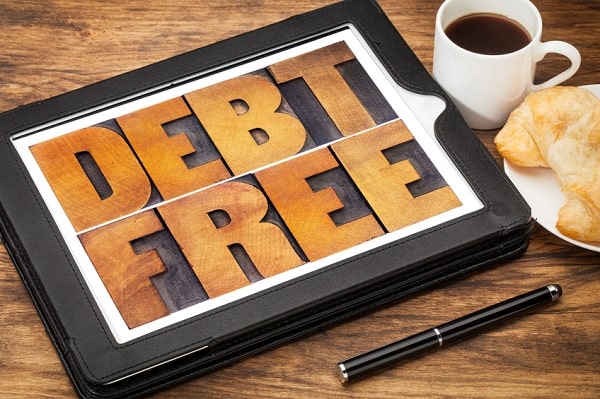Debt-Free S&P 500 Companies List 2024 (Updated Quarterly)
This page contains links to our partners. RBD may be compensated when a link is clicked. Read disclosures.
Updated 03/07/2024 with fresh data. Scroll down the page to find the current list of debt-free S&P 500 companies.
There are now zero debt-free companies in the S&P 500. The one holdout from last year borrowed in Q4 2023.
Most S&P 500 companies borrowed money when lending rates were cheap. But now that interest rates are much higher, we expect companies to be less likely to borrow going forward.
We expect hope to see this list to grow in 2024 and beyond and will update the table about every three months. Higher interest rates lower the propensity to borrow.
So you have something more to look at, I’ve included the one debt-free company and seven additional companies in the S&P 500 with the least amount of debt (below $100 million) in the table below.
The best way to own some or all the debt-free stocks is through M1 Finance (review) M1 Finance is a commission-fee online brokerage built for long-term investors.

How much debt is on the balance sheet?
That’s one of the first questions I like to answer when I’m evaluating a stock. Companies borrow money for a myriad of reasons, including to launch business lines, fund acquisitions, fund operations, and sometimes to fund distributions to shareholders.
Smart MBAs sit in office suites and perform elaborate spreadsheet wizardry to try and determine what is the optimal level of debt to maximize profits. It’s complicated. I took a corporate finance class in college and hated it.
But I can still look at a balance sheet and determine if I’m comfortable with the amount of debt held or not. Sometimes companies get too aggressive and think they can borrow lots to make more money. But business and market conditions can change.
Borrowing can get out of hand. When there isn’t enough money to cover the debt payments, that’s when bankruptcies occur.
But nobody ever went bankrupt while debt-free.
Table of Contents
List of Debt-Free/Lowest Debt S&P 500 Companies 2024
See the screening criteria below to see how we determined there are no debt free S&P 500 companies anymore.
You’ll find other websites with similar lists with less stringent criteria. Most other website lists are outdated.
This list only consisted completely debt-free stocks in the past. But there are no more S&P 500 debt-free stock as of the latest update.
As of March 2024, only eight companies in the S&P 500 have less than $100 million of debt on the balance sheet. So we’ve included them here.
Intuitive Surgical (ISRG) was the last debt-free holdout, but borrowed in Q4 2023.
Debt numbers updated as of 03/07/2024. Price, market cap, and PE updated in real-time.
| # | SYMBOL | COMPANY NAME | TOTAL DEBT | CURRENT PRICE | MKT CAP | P/E |
|---|---|---|---|---|---|---|
| 1 | MPWR | Monolithic Power Systems | 7.87M | 677.23 | $32 Billion | 77.28 |
| 2 | INCY | Incyte Corporation | 52.57M | 51.68 | $11 Billion | 19.54 |
| 3 | ANET | Arista Networks | 65.52M | 264.7 | $82 Billion | 40.22 |
| 4 | MNST | Monster Beverage | 66.02M | 53.37 | $55 Billion | 34.62 |
| 5 | PAYC | PayCom | 75.95M | 188.89 | $10 Billion | 32.13 |
| 6 | MKTX | MarketAxess Holdings | 79.68M | 201.79 | $7 Billion | 29.44 |
| 7 | TER | Teradyne | 82.61M | 114.13 | $17 Billion | 41.79 |
| 8 | ISRG | Intuitive Surgical | 89.80M | 375.33 | $133 Billion | 67.73 |
An Updated Resource for Risk-Averse Investors
Debt-free companies are some of the safest for investors because there are no debt payments hindering cash flow, and the risk of going under due to debt default is zero.
However, the perception to some is that if a company doesn’t borrow money, it’s not taking enough risk to spur growth and is, therefore, falling behind competitors, especially with today’s low rates.
If your investment risk tolerance is low, this list may be an attractive starting point for further investment research.
There’s a lack of resources to quickly identify these companies with consistent updates.
The list of companies has been shrinking. Many that were debt-free have fallen to the temptation of low-rate money. This could be a good thing.
Apple (AAPL) and Microsoft (MSFT) are two high-profile companies that were debt-free for a very long time but are no longer. Perhaps we should applaud companies for taking advantage of low rates to grow their businesses.
But not taking advantage of low rates doesn’t mean the company is bad. Conservative, maybe. Or maybe they just have all the capital they need to grow.
Due to investor demand for a current and updated list of debt-free S&P 500 companies, I’ve compiled this list and plan to update it quarterly.
Of course, this list doesn’t tell the whole story. Some companies have low amounts of debt and more cash on hand to cover the liability if needed. Those companies may also be worthy of consideration, but I’m only covering completely debt-free companies in the S&P 500 index on this page.
Before looking at the list, I’ll explain how I identified these stocks.
Screening Criteria for the Debt-Free S&P 500 Companies 2024 List
Note: This list is only as good as the data behind it. There is no guarantee of accuracy in the table below.
Companies are borrowing more and more these days because debt is so cheap. The list has atrophied over the past few years.
To identify the list of debt-free S&P 500 stocks, I start with the complete list of 500 companies compiled by Standards & Poors.
After testing various screeners and tools, I’ve settled on the FinViz stock screener using LT Debt/Equity <0.1, Debt/Equity <0.1, and index = S&P 500.
I then cross-check the list against Seeking Alpha where Total Debt = $0.00. Stocks on both lists make the cut.
Several companies on the FinViz Stock Screener have enough cash to pay off the debt. But they still have debt on the balance sheet.
Company balance sheets change every quarter. Due to data variations and annual/quarter reporting, the list may not always be precise at a given moment.
Keep in mind, this list is not a recommendation to buy or sell these stocks. For investors that value conservative management or a debt-free lifestyle, this may be a starting point to add positions to your portfolio.
As always, conduct further research before buying or selling any stock mentioned in this article.
If you see any discrepancies in this list or or have suggestions for a more comprehensive screener, please contact me or add a note in the comments section.
Easily Buy all the Debt-Free S&P 500 Companies Commission-Free
You can attempt to buy each debt-free S&P 500 company one at a time at your primary brokerage. I prefer a more efficient method.
I’m a big fan of the online broker M1 Finance. It’s a commission-free online brokerage. With M1 Finance, you can create your own “pie” which is a customized investment plan where you can decide which stocks or ETFs to own.
When you add new funds to your account, the funds are automatically allocated to your investment plan, starting with the most undervalued stocks at the time of investment. You can choose all the debt-free stocks and make them one piece of a diversified portfolio.
There are no trading or transaction fees, period. I’m impressed by this now mature platform. It’s a type of robo-adviser for active investors. You choose the allocations first, then M1 Financial automatically invests your money to match your ideal portfolio.
Read a comprehensive M1 Finance review here.
Help Selecting the Best Dividend Stocks for Income
For those looking for help in selecting the best dividend growth and retirement income stocks, I use and recommend The Sure Dividend Pro Plan.
I’ve been a paid subscriber of this newsletter bundle to supplement my own stock research for the past four years.
Use the Sure Dividend coupon code “RBD100S” to save $100 on an annual subscription.
Conclusion
This post isn’t meant to spur debate over whether it’s smart for a company to borrow or not. Each company has different business models and capital needs to operate.
My college corporate finance grade was one I want to forget. But I still have a personal preference towards companies with relatively low debt levels, although not all of my holdings fit that description.
I’ve owned heavily indebted companies and watched the value of the stock price plummet. I’ve also owned heavily indebted companies that pay me dividends year after year without issue.
Some investors may value a completely debt-free company over a debt-laden stock as a matter of investment safety or even personal or religious values. Use this list of debt-free S&P 500 companies 2024 however you like.
Featured photo credit: iStock.com/marekuliasz used under license as of 09/20/16
Disclosure: RBD is an affiliate partner with M1 Finance. If you open an account via any links in this M1 Finance review, RBD may be compensated. M1 is a technology company offering a range of financial products and services. “M1” refers to M1 Holdings Inc., and its wholly-owned, separate affiliates M1 Finance LLC, M1 Spend LLC, and M1 Digital LLC. The opinions expressed are solely those of the authors and do not reflect the views of M1. They are for informational purposes only and are not a recommendation of an investment strategy or to buy or sell any security in any account. They are also not research reports and are not intended to serve as the basis for any investment decision. Prior to making any investment decision, you are encouraged to consult your personal investment, legal, and tax advisors.

Craig is a former IT professional who left his 19-year career to be a full-time finance writer. A DIY investor since 1995, he started Retire Before Dad in 2013 as a creative outlet to share his investment portfolios. Craig studied Finance at Michigan State University and lives in Northern Virginia with his wife and three children. Read more.
Favorite tools and investment services right now:
Sure Dividend — A reliable stock newsletter for DIY retirement investors. (review)
Fundrise — Simple real estate and venture capital investing for as little as $10. (review)
NewRetirement — Spreadsheets are insufficient. Get serious about planning for retirement. (review)
M1 Finance — A top online broker for long-term investors and dividend reinvestment. (review)
